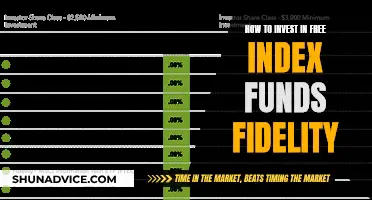
A mutual fund is a type of investment vehicle that pools money from multiple investors to purchase a diversified portfolio of stocks, bonds, or other securities. An S&P mutual fund is a type of mutual fund that buys stock in the companies on the S&P 500 index, which tracks the performance of the top 500 American companies on the stock market.
| Characteristics | Values |
|---|---|
| Type of Investment | Mutual Fund |
| Type of Mutual Fund | Index Fund |
| Investment Strategy | Passive |
| Investment Objective | Broad Exposure to S&P 500 Index |
| Investment Holdings | Stocks of 500 Largest U.S. Companies |
| Investment Returns | Average Market Returns |
| Investment Risk | Volatile, Equity Risk |
| Investment Costs | Annual Fees, Expense Ratios, Commissions |
| Investment Accessibility | Accessible Through Brokerage Accounts, 401(k)s, IRAs |
What You'll Learn
- S&P 500 index funds are a type of mutual fund
- They are passively managed and designed to mirror the performance of the S&P 500 index
- They are popular due to their diversification, low fees and long-term performance
- Investors can buy into S&P 500 index funds through brokerages or robo-advisors
- S&P 500 index funds are a safe, long-term investment option

S&P 500 index funds are a type of mutual fund
S&P 500 index funds are ideal for investors seeking returns in line with the broader market, but who don't want to own individual stocks. They are designed to mirror the performance of the S&P 500 index, investing in each of the 500 companies included in the index.
These funds are a popular choice as they offer easy portfolio diversification and are passively managed, resulting in lower expense ratios compared to actively managed funds. S&P 500 index funds are also low-cost investments, allowing investors to keep more of their profits.
Some of the top S&P 500 index funds include the Fidelity 500 Index Fund, Schwab S&P 500 Index Fund, and Vanguard 500 Index Fund Admiral Shares. These funds have very low expense ratios, ranging from 0.015% to 0.04%.
S&P 500 index funds provide investors with instant diversification, broad exposure to leading U.S. companies, and a track record of delivering profits over long holding periods. They are a safe and effective way to build wealth over time.
The Best Time to Invest in Funds: Morning or Evening?
You may want to see also

They are passively managed and designed to mirror the performance of the S&P 500 index
S&P 500 mutual funds are passively managed, meaning that they are not actively managed by a fund manager. Instead, they are designed to mirror the performance of the S&P 500 index. This means that the fund's performance will be directly linked to the performance of the index, which tracks the stock market performance of the top 500 American companies.
The S&P 500 index fund is a type of mutual fund that purchases stock in the companies on the S&P 500 index. The index includes the top 500 American companies by market capitalization, which is the total dollar value of their issued shares. By investing in an S&P 500 mutual fund, you will own shares of all 500 stocks that make up the index. This provides investors with broad exposure to the constituent stocks and instant diversification of their portfolio.
The S&P 500 index fund is a passive investment, meaning it is not actively managed by a fund manager. The fund is designed to replicate the performance of the S&P 500 index, so it will perform no better or worse than this section of the market. This means that investors will get "average" returns, which have historically been in the range of 9% to 10% annually. While the index has always recovered from losses over the long term, there is still the possibility of short-term volatility and downside risk.
The passive management of S&P 500 mutual funds results in a lower expense ratio compared to actively managed funds. This is because there are lower investment management fees, as the fund simply mirrors the index rather than requiring active fund management. As a result, S&P 500 index funds are a low-cost investment option, making them attractive to investors.
Overall, S&P 500 mutual funds offer investors a way to mirror the performance of the S&P 500 index, providing broad exposure to the top 500 American companies. By investing in this type of fund, investors can benefit from instant portfolio diversification, lower fees, and historical returns that have been in line with the broader market.
Crowdfunding: Investing for All, Without Barriers
You may want to see also

They are popular due to their diversification, low fees and long-term performance
S&P mutual funds are a type of investment vehicle that pools money from multiple investors to purchase a diversified portfolio of stocks. They are a passive form of investing, designed to mirror the performance of the index they track. For example, an S&P 500 index fund will hold the stocks that make up the S&P 500 index in an effort to match its performance.
S&P mutual funds are popular due to their diversification, low fees, and long-term performance:
Diversification
S&P mutual funds offer immediate diversification, as they allow investors to own a wide variety of stocks across different industries and sectors. For example, the S&P 500 index fund provides exposure to 500 leading U.S. companies across 11 major industries, with no sector having more than 30% of the money invested. This diversification helps to lower investment risk and provides investors with access to a wide range of assets.
Low Fees
S&P mutual funds tend to have low expense ratios, which means investors are charged low annual fees. The fees for S&P mutual funds are typically lower than those for actively managed funds, as they do not have teams of analysts and portfolio managers trying to beat the market. Lower fees result in higher returns for investors.
Long-Term Performance
S&P 500 index funds, in particular, have a long-term record of solid returns, with an average annual return of about 10%. While returns can vary from year to year, the S&P 500 has consistently performed well over extended periods. This consistent long-term performance makes S&P mutual funds attractive to investors seeking stable, long-term investments.
Maximizing Your Roth IRA: Alternative Investment Options
You may want to see also

Investors can buy into S&P 500 index funds through brokerages or robo-advisors
An S&P 500 index fund is based on about 500 of the largest American companies, meaning it comprises many of the most successful companies in the world. For example, Amazon and Berkshire Hathaway are two of the most prominent member companies in the index.
If you want to achieve higher returns than more traditional banking products or bonds, a good alternative is an S&P 500 index fund, though it does come with more volatility. An S&P 500 index fund is an excellent choice for beginning investors because it provides broad, diversified exposure to the stock market. An S&P 500 index fund is a good choice for any stock investor looking for a diversified investment and who can stay invested for at least three to five years.
An S&P 500 fund is one of the less-risky ways to invest in stocks, because it’s made up of the market’s top companies and is highly diversified. Of course, it still includes stocks, so it’s going to be more volatile than bonds or any bank products. It’s also not insured by the government, so you can lose money based on fluctuations in value. However, the index has done quite well over time.
The index rallied furiously after its pandemic-driven plunge in March 2020, but performed poorly in 2022, so investors should stick to their long-term investment plan if they invest here.
Like nearly any fund, an S&P 500 index fund offers immediate diversification, allowing you to own a piece of all of those companies. The fund includes companies from every industry, making it more resilient than many investments.
Over time, the index has returned about 10% annually. These funds can be purchased with very low expense ratios (how much the management company charges to run the fund) and they’re some of the best index funds.
You can purchase an S&P 500 index fund at any broker that allows you to trade ETFs or mutual funds. ETFs are typically commission-free, so you won’t pay any extra charge, whereas mutual funds may charge a commission and require you to make a minimum purchase.
To invest in S&P 500 ETFs, investors can gain exposure through discount brokers with commission-free trading. S&P 500 index funds trade through brokers and discount brokers and may be accessed directly from the fund companies. Investors may also access ETFs and mutual funds through employer 401(k) programs, individual retirement accounts (IRA), or robo-advisor platforms.
Nearly all major brokerages and fund companies offer some type of S&P 500 fund, such as the iShares S&P 500 Value ETF (IVE), the SPDR Portfolio S&P 500 Value ETF (SPY), and the Vanguard S&P 500 Value ETF (VOO).
Best S&P Index Funds: Top Picks for Your Portfolio
You may want to see also

S&P 500 index funds are a safe, long-term investment option
Index funds are passively managed, meaning they are designed to mirror the performance of the index. In this case, an S&P 500 index fund will perform no worse or better than the market section it is tracking. This means that, while returns may be average, the risk is also lower.
The S&P 500 index is considered the best single gauge of large-cap U.S. equities and accounts for 80% of the stock market's value. The index includes 500 leading U.S. companies, though this number may fluctuate, and represents a diverse range of 11 major industries. As of May 2024, the top 10 companies in the index by weight included Microsoft, Amazon, Alphabet, Meta, and Berkshire Hathaway.
S&P 500 index funds can be purchased through several investment firms, with the main difference between them being the expense ratios, or fees. While these funds tend to have slightly higher fees than ETFs, they are still a good option for investors looking for broad exposure to the U.S. market.
There are several advantages to investing in the S&P 500. Firstly, it provides exposure to some of the world's most dynamic companies, including Apple, Amazon, Walmart, and Johnson & Johnson. Secondly, it offers consistent long-term returns, although individual yearly returns may vary. Thirdly, intricate analysis is not required, as the fund mirrors the market. Finally, S&P 500 index funds are liquid and trade with tight bid-ask spreads, making them ideal as core holdings.
However, there are also some disadvantages to consider. The S&P 500 is dominated by large-cap companies, with its 10 biggest constituents accounting for almost one-third of the index. This means that the index has limited exposure to small-cap and mid-cap stocks, which may have higher growth potential. Additionally, the index only includes U.S. companies and has risks inherent in equity investing, such as volatility and downside risk.
Dave Ramsey's Investment Strategy: Specific Fund Choices
You may want to see also
Frequently asked questions
An S&P 500 index fund tracks the S&P 500, a market index that measures the performance of about 500 large U.S. companies publicly traded on the New York Stock Exchange and NASDAQ.
When choosing an S&P 500 index fund, look for one with low fees and one that doesn't require a large minimum investment.
The S&P 500 offers investors a lot of diversification and exposure to some of the world's most dynamic companies. It has consistently performed well over the long term.
The S&P 500 is dominated by large-cap companies, so it has limited exposure to small-cap and mid-cap stocks. It also only includes U.S. companies and has risks inherent in equity investing.







